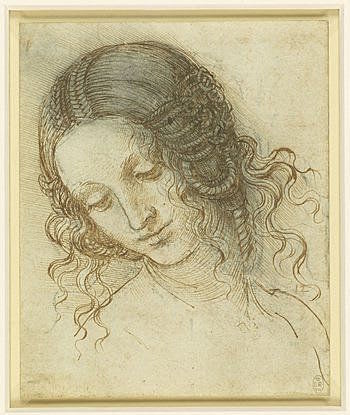The day I visit—rather late in its London run—Leonardo da Vinci: A Life in Drawing at the Queen’s Gallery, it is sold out, but then, of course, Leonardo da Vinci needs no promotion. Visitors, tourists, art lovers throng and pack the gallery, several deep in front of the delicate drawings, making it difficult to contemplate their unique artistry. And one needs to contemplate, to look closely at the phenomenal range of talents of this singular man.
Celebrating the 500th anniversary of his death, the largest exhibition of Leonardo’s work in over 65 years has been brought together at the Queens Gallery in London. Two hundred out of some 550 of his drawings, which have been kept together as a group in the Royal Collection since the seventeenth century, are presented here.
Originally bound in an album (on display) made up for Pompeo Leoni in the late sixteenth century, brought to England around 1620 and in the Royal Collection by 1690, acquired by Charles II probably around 1670. In the nineteenth century Leonardo’s drawings were removed from the album “to protect and display them”.
But here’s the rub—they were in an album for private viewing, held in hand, spread on table or stand, and now we multitudes are grateful to catch a glimpse of them over people’s heads. Thankfully, the web site is fulsome and generous with images and historical background with fine notes on each image. Do have a look.
Leonardo da Vinci: A Life in Drawing is beautifully curated by Martin Clayton, Head of Prints and Drawings—there’s a Q&A page with him on the web site. If nothing else, the exhibition appeals to the autodidact in us, maybe paralleling Leonardo’s seemingly insatiable inquisitiveness. The man was a polymath—that we know—but with modern technology, ultra-violet techniques, specialists have revealed details that have been lost for centuries. And the mind boggles anew at the exquisite delicacy of his vision, line and technique.
A man before his time, his drawings astonish with their modernity and prescience. His interests ranged from painting, drawing and sculpture to architecture, engineering, and cartography, to anatomy, geology and botany. The archetypal ‘Renaissance man’… his apocalyptic deluge sketches foretell of “a cataclysmic storm overwhelming the earth and sweeping away all matter”... a climate catastrophe we are only just beginning to take seriously today...
Astonishing to read that, “revered in his day as a painter, Leonardo completed only around 20 paintings; he was respected as a sculptor and architect, but no sculpture or buildings by him survive; he was a military and civil engineer who plotted with Machiavelli to divert the river Arno, but the scheme was never executed; he was an anatomist and dissected 30 human corpses, but his ground-breaking anatomical work was never published; he planned treatises on painting, water, mechanics, the growth of plants and many other subjects, but none was ever finished.”
We may know his paintings, but with these intimate personal drawings, private musings in a way, workings out of ideas on paper, we see the jaw-dropping breadth and scope of a formidable mind. It is hard to think that what we are seeing is only the tip of an iceberg, that “many of his projects failed to reach fruition, and his scientific investigations were almost entirely unrecognised in his own day”, that “so much of his life's work was unrealised or destroyed”.
February to May 2019, 144 of Leonardo’s drawings from the Royal Collection were on display in 12 simultaneous exhibitions at museums and galleries across the UK. In May 2019 200 drawings were brought together at The Queen’s Gallery, Buckingham Palace, and now, from 22 November 2019 to 15 March 2020, eighty of them go The Queen’s Gallery, Palace of Holyroodhouse.
Try and go on a quiet day, or maybe several visits are in order. Maps, dissected skulls, wombs, the cardiovascular system and more, drawings for public equestrian monuments, civil engineering plans, even costume designs, but it is the natural world, his botanical drawings and his preparatory drawings for paintings (not all realised)—drapery of a figure kneeling, a study of a woman’s hands, studies for the head of Leda with its intricate hairstyle, its coils and braids, or the head of St Anne—that I take away with me.
